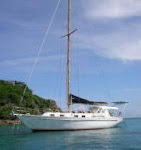
It was a great sail over to over to Montserrat with a following wind and sparkling seas.

As we approached this great gray angled plain showed up on the East side of Montserrat,

at the time I thought it was the aftermath of a pyroclastic flow but later learned that it was a lehar or mud flow event. It had even pushed out some way into the sea and these events are reshaping the coast line of Montserrat and laying traps for unwary sailors. One of which ignored the warnings on the chart and 3 weeks ago went aground on the west side probably on a new sandbank from a mud flow.
Our guide to the Islands said that Joe Phillips AKA Avalon was the man to take the Island tour with and a call to Avalon on the VHF had him waiting for us as we cleared Customs and Immigration. There are less than 5000 people on the island and Joe seems to know them all. We stopped off at the new seat of government and saw the brand spanking new jail which had a been a priority for some reason. Still it is only EU money!

The Island is divided into zones and although Joe's house is untouched by the volcano so far it is in a no go zone. So he is building again and says he will be in by the coming Christmas, I think he will have to put in some serious hours to get it habitable.
Many of the locals forced out of the capital Plymouth relocated to the north and built a temporary wooden home as the scientists thought the eruption would last for five years, that was 15 years ago and it is still pushing out lava today and in February this year there was a spectacular eruption that sent ash to 50,000 feet and closed some airports in nearby islands. So many of these temporary houses are being rebuilt with cement blocks as people settle down in the North.
We stopped at the volcano observatory and watched a video chronicling the history of the eruptions since 1995 with many spectacular night time shots of the red hot ash and giant rocks rolling down the sides of the building dome.
Montserrats Soufriere volcano is an andesite volcano and does not produce the slow flowing red lava like the Hawaian ones, instead it produces ash and pumice style rock which looks grey by day as it dribbles down the sides of the dome but at night it glows as the very fires of hell.

Joe then took us into the area affected by one of the biggest dangers from this type of volcano, mud flows. One of the things that makes his tour special is that he has collected pictures of the area before the volcano blew,

such as this two story house which stood above the golf course .

Joe said that he thinks the next big rains will bring a mud flow that will cover the house up completely.
We walked on the roof after Joe showed us the house was full to the roofline with solidified material.
The recent one added about 2 feet to the existing deposit and was a boiling mud flow straight from the hot areas of the volcano, hot enough to turn to charcoal the wood it collected on it's way.
We then climbed up to the peak of Garibaldi with Joe having to give his little Toyota some real stick up the very steep track so we could look down on Plymouth. The houses and buildings are a memorial to a town that was. The swath of missing houses in the center was the result of a pyroclastic flow which leveled them and carried rocks the size of cars down to the sea.


A pyroclastic flow is a fluidized mixture of solid to semi-solid fragments and hot, expanding gases that flows down the flank of a volcano. These awesome features are heavier-than-air emulsions that move much like a snow avalanche, except that they are fiercely hot, contain toxic gases, and move at phenomenal, hurricane-force speeds, often over 100 km/hour. They are the most deadly of all volcanic phenomena.
The andesite rocks float and pose a new threat to navigation in the area.
The tongues of new land are growing out to sea with each flow from the volcano dome.
Joe drove us down the hill then went off roading down the mud flow that covered the golf course. This was on the “safe” side of Garibaldi and to prove it people actually live on both sides of the flow although they are cut off during every flow event.


We parked on the end of the old quay but were still a long way from the new waters edge. See the old and the new pics. Actually we had parked where there was ocean before and the only thing left was a bit of rusty pipe sticking from the mud which had held the light on the land side.

The mud flows have covered the quay and filled in the bay completely!
Back on the boat it was time to enjoy our evening meal, the sunset and the squabbling seabirds as they fought for squatters rights on this buoy.
Next day it was on to Deshaies, Guadaloupe, where we were greeted by a fine double rainbow.


No comments:
Post a Comment